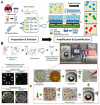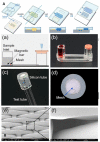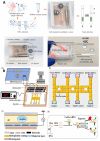Microfluidics for COVID-19: From Current Work to Future Perspective
- PMID: 36831930
- PMCID: PMC9953302
- DOI: 10.3390/bios13020163
Microfluidics for COVID-19: From Current Work to Future Perspective
Abstract
Spread of coronavirus disease 2019 (COVID-19) has significantly impacted the public health and economic sectors. It is urgently necessary to develop rapid, convenient, and cost-effective point-of-care testing (POCT) technologies for the early diagnosis and control of the plague's transmission. Developing POCT methods and related devices is critical for achieving point-of-care diagnosis. With the advantages of miniaturization, high throughput, small sample requirements, and low actual consumption, microfluidics is an essential technology for the development of POCT devices. In this review, according to the different driving forces of the fluid, we introduce the common POCT devices based on microfluidic technology on the market, including paper-based microfluidic, centrifugal microfluidic, optical fluid, and digital microfluidic platforms. Furthermore, various microfluidic-based assays for diagnosing COVID-19 are summarized, including immunoassays, such as ELISA, and molecular assays, such as PCR. Finally, the challenges of and future perspectives on microfluidic device design and development are presented. The ultimate goals of this paper are to provide new insights and directions for the development of microfluidic diagnostics while expecting to contribute to the control of COVID-19.
Keywords: COVID-19; immunoassays; microfluidic; molecular assays.
Conflict of interest statement
The authors declare no conflict of interest.
Figures











Similar articles
-
Microfluidics-Based Point-of-Care Testing (POCT) Devices in Dealing with Waves of COVID-19 Pandemic: The Emerging Solution.ACS Appl Bio Mater. 2022 May 16;5(5):2046-2068. doi: 10.1021/acsabm.1c01320. Epub 2022 Apr 27. ACS Appl Bio Mater. 2022. PMID: 35473316 Review.
-
Reimagining point-of-care assays: Automated digital microfluidics for multiplex in vitro diagnostics.Talanta. 2025 Nov 1;294:128270. doi: 10.1016/j.talanta.2025.128270. Epub 2025 May 3. Talanta. 2025. PMID: 40327981 Review.
-
Recent advances in non-optical microfluidic platforms for bioparticle detection.Biosens Bioelectron. 2023 Feb 15;222:114944. doi: 10.1016/j.bios.2022.114944. Epub 2022 Nov 30. Biosens Bioelectron. 2023. PMID: 36470061 Review.
-
Towards practical sample preparation in point-of-care testing: user-friendly microfluidic devices.Lab Chip. 2020 Apr 7;20(7):1191-1203. doi: 10.1039/d0lc00047g. Epub 2020 Mar 2. Lab Chip. 2020. PMID: 32119024 Review.
-
Lab-on-a-Chip Devices for Point-of-Care Medical Diagnostics.Adv Biochem Eng Biotechnol. 2022;179:247-265. doi: 10.1007/10_2020_127. Adv Biochem Eng Biotechnol. 2022. PMID: 32435872 Review.
Cited by
-
Establishment and Validation of an Integrated Microfluidic Step Emulsification Chip Supporting Droplet Digital Nucleic Acid Analysis.Biosensors (Basel). 2023 Sep 18;13(9):888. doi: 10.3390/bios13090888. Biosensors (Basel). 2023. PMID: 37754123 Free PMC article.
-
Rapid assays of SARS-CoV-2 virus and noble biosensors by nanomaterials.Nano Converg. 2024 Jan 8;11(1):2. doi: 10.1186/s40580-023-00408-z. Nano Converg. 2024. PMID: 38190075 Free PMC article. Review.
-
Microsystem Advances through Integration with Artificial Intelligence.Micromachines (Basel). 2023 Apr 8;14(4):826. doi: 10.3390/mi14040826. Micromachines (Basel). 2023. PMID: 37421059 Free PMC article. Review.
-
Application of a SARS-CoV-2 Antigen Rapid Immunoassay Based on Active Microfluidic Technology in a Setting of Children and Young Adults.Viruses. 2023 Dec 26;16(1):41. doi: 10.3390/v16010041. Viruses. 2023. PMID: 38257741 Free PMC article.
-
Unveiling the state of the art: a systematic review and meta-analysis of paper-based microfluidic devices.Front Bioeng Biotechnol. 2024 Aug 21;12:1421831. doi: 10.3389/fbioe.2024.1421831. eCollection 2024. Front Bioeng Biotechnol. 2024. PMID: 39234268 Free PMC article.
References
-
- WHO Coronavirus (COVID-19) Dashboard|WHO Coronavirus (COVID-19) Dashboard with Vaccination Data. [(accessed on 31 October 2022)]. Available online: https://covid19.who.int/
Publication types
MeSH terms
Grants and funding
LinkOut - more resources
Full Text Sources
Medical

